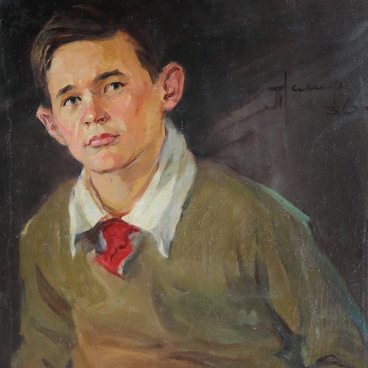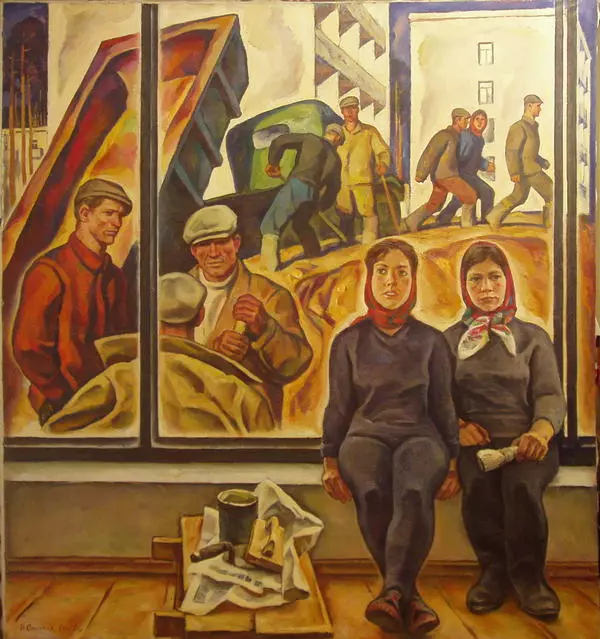The artist Igor Simonov, who depicted the harsh yet beautiful Ural nature, often addressed the industrial side of the region as well. The theme was embodied through the images of his compatriots — strong and courageous, tough and experienced, true heroes of the country. Steelworkers, foundry workers, and builders were the main characters in Simonov’s paintings. The artist’s choice of themes and painting style have always been closely associated with “the austere style”.
“The austere style” was a Soviet art movement that gained popularity and recognition in the mid-20th century. To some extent, it found its way into all genres, depicting labor and a Soviet man as the most important part of it. The style was characterized by the glorification of the life of ordinary people and their hard work. The austere style painters concentrated on the dramatic fate of contemporaries and older generations. Many of the artists adopted a restrained, generalized, and conventional manner that embraced minimalistic realism. The images in such paintings were usually simplified and concise. The expressiveness was based on large spots of color and clear outlines of figures.
Igor Simonov placed great importance on the general mood and atmosphere of the canvas. He used to ponder on the images for his works. The artist took trips to construction sites and plants to collect material for his works. He would then wait a great deal of time for the minor details to disappear from his memory leaving the overall impression that would eventually become the subject of his painting.
The 1971 painting “Foundation Pit” is Simonov’s reinterpretation of his eponymous artwork of 1969. According to the artist, this painting was the result of a visit he paid to the town of Kachkanar, which was developing rapidly in the 1960s. After almost ten years, the painter still had the memory of the large construction site: the clang of iron, the roar of dump trucks, and the pit overcrowded with people and equipment. This intense atmosphere of the construction, its scope and great capacity is just what Simonov strove to embody in his work.
The composition faces the viewers, making them both onlookers and participants. The dynamic of the workers’ figures is achieved through accents of graphic painting and chiaroscuro. The figures seem to be stepping out from the canvas, and this reflects the main idea of Igor Simonov: the importance of a human with all their complex, fascinating, and rich inner world will always be paramount.
“The austere style” was a Soviet art movement that gained popularity and recognition in the mid-20th century. To some extent, it found its way into all genres, depicting labor and a Soviet man as the most important part of it. The style was characterized by the glorification of the life of ordinary people and their hard work. The austere style painters concentrated on the dramatic fate of contemporaries and older generations. Many of the artists adopted a restrained, generalized, and conventional manner that embraced minimalistic realism. The images in such paintings were usually simplified and concise. The expressiveness was based on large spots of color and clear outlines of figures.
Igor Simonov placed great importance on the general mood and atmosphere of the canvas. He used to ponder on the images for his works. The artist took trips to construction sites and plants to collect material for his works. He would then wait a great deal of time for the minor details to disappear from his memory leaving the overall impression that would eventually become the subject of his painting.
The 1971 painting “Foundation Pit” is Simonov’s reinterpretation of his eponymous artwork of 1969. According to the artist, this painting was the result of a visit he paid to the town of Kachkanar, which was developing rapidly in the 1960s. After almost ten years, the painter still had the memory of the large construction site: the clang of iron, the roar of dump trucks, and the pit overcrowded with people and equipment. This intense atmosphere of the construction, its scope and great capacity is just what Simonov strove to embody in his work.
The composition faces the viewers, making them both onlookers and participants. The dynamic of the workers’ figures is achieved through accents of graphic painting and chiaroscuro. The figures seem to be stepping out from the canvas, and this reflects the main idea of Igor Simonov: the importance of a human with all their complex, fascinating, and rich inner world will always be paramount.




